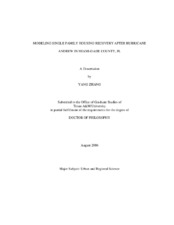| dc.description.abstract | This research seeks to improve the current state of knowledge about housing
recovery following a major natural disaster through examining single family housing
recovery following Hurricane Andrew, a category 5 hurricane, which impacted southern
sections of Miami-Dade County in 1992. This inquiry focused on two questions: (1)
what is the recovery process for single family housing in a disaster impact area, and (2)
how does the housing recovery process vary across households and neighborhoods? To
answer these questions, the 1992-96 tax appraisal values for Miami-Dade County were
used to measure housing damage and recovery after the storm. Hierarchical Linear
Modeling (HLM) was used to quantitatively model this recovery process and identify the
major factors in play.
With regard to the first question, our findings suggested that Hurricane Andrew
caused extensive housing damage in the impact area, rendering an average loss to
households of 50.4% of pre-disaster home value. Two years after the storm (1994), the
average home value returned to its pre-disaster level. In the subsequent two years (1995-96), the average home value continued growing, representing a 7.6% and 14.9% gain,
respectively, over the pre-disaster average.
Regarding the second question, our analysis found that the housing recovery
process varied significantly across households and neighborhoods. Owner-occupied
homes recovered more rapidly than rental units. Household income had a positive effect
on housing recovery. Our analysis also suggested that post-disaster home sales had a
significant negative effect on housing recovery. Neighborhood race/ethnicity
composition affected the housing recovery process. Homes in minority populated
neighborhoods (both Hispanic and non-Hispanic Black) recovered more slowly than
homes in majority populated areas (non-Hispanic White). When considering Cuban-
Hispanics and non-Cuban Hispanics as two separate groups, neighborhoods with a
higher concentration of Cuban-Hispanics, while having no clear advantage at the
beginning of the recovery period, recovered more rapidly than other minority populated
areas.
Previous studies suggested that the long-term impact of natural disasters at the
aggregated level is minimal, and yet our results showed that the housing impact of
Hurricane Andrew lasted at least more than four years. In fact, housing inequality in the
impact area increased markedly during the recovery process due to the unequal nature of
housing recovery. | en |


